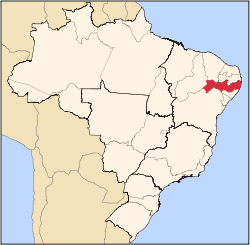Olinda
| Olinda | |||
|---|---|---|---|
| Municipality | |||
| The Municipality of Olinda | |||
|
|||
 |
|||
| Location in Brazil | |||
| Coordinates: 8°0′32″S 34°51′18″W / 8.00889°S 34.85500°W | |||
| Country |
|
||
| Region | Northeast | ||
| State |
|
||
| Founded | March 12, 1535 | ||
| Incorporated (as village) | 1537 | ||
| Incorporated (as city) | 1676 | ||
| Government | |||
| • Mayor | Renildo V. Calheiros | ||
| Area | |||
| • Municipality | 43.55 km2 (27.1 sq mi) | ||
| • Metro | 2,768 km2 (1,068.7 ;) sq mi) | ||
| Elevation | 16 m (52 ft) | ||
| Population (2015) | |||
| • Municipality | 389,494 | ||
| • Density | 5.660/km2 (14.659/sq mi) | ||
| • Metro | 3,768,902 | ||
| Time zone | UTC-3 (UTC-3) | ||
| HDI (2000) |
|
||
| Website | Olinda, Pernambuco | ||
| Historic Centre of the Town of Olinda | |
|---|---|
| Name as inscribed on the World Heritage List | |
| Location | Brazil |
| Type | Cultural |
| Criteria | ii, iv |
| Reference | 189 |
| UNESCO region | Latin America and the Caribbean |
| Inscription history | |
| Inscription | 1982 (6th Session) |
Olinda (Portuguese pronunciation: [oˈlĩdɐ]), is an historic city in the Brazilian state of Pernambuco, located on the country's northeastern Atlantic Ocean coast, just north of Recife and south of Paulista. It has a population of 389,494 people, covers 41.681 square kilometres (16.093 sq mi), and has a population of 9 inhabitants per square kilometer. It is noted as one of the best-preserved colonial cities in Brazil.
Olinda features a number of major tourist attractions, such as a historic downtown area (World Heritage Site), churches, and the Carnival of Olinda, a popular street party, very similar to traditional Portuguese carnivals, with the addition of African influenced dances. Unlike in Rio de Janeiro and Salvador, in Olinda, admission to Carnival is free. All the festivities are celebrated on the streets, and there are no bleachers or roping. There are hundreds of small musical groups (sometimes featuring a single performer) in many genres.
Several indigenous tribes occupied the coast of Northeastern Brazil for several thousand years, and the hills of the present day municipality of Olinda had settlements of Caetés and Tupinambá tribes, which were frequently at war. French mercenaries are thought to be the first Europeans to get to the region, but the Portuguese exploited intertribal rivalries and managed to build a stronghold on the former Caeté village in the higher hill. Recent studies by the Universidade Federal de Pernambuco [Federal University of Pernambuco] have uncovered new evidence of the pre-colonial population of the area. The settlement of Olinda was founded in 1535 by Duarte Coelho Pereira; it was elevated to a town on March 12, 1537. It was made the seat of the Territorial Prelature of Pernambuco in 1614, becoming the Diocese of Olinda in 1676. The economy of the region was dominated by the production of sugarcane. The importation of slaves from Africa to support the economy made Olinda a colonial stronghold. By 1600 its economy was based on sugar, and imported African slave labor had made it a colonial stronghold. Slavery existed in Olinda until the Lei Áurea, or Golden Law, abolished slavery in Brazil in 1888.
...
Wikipedia




